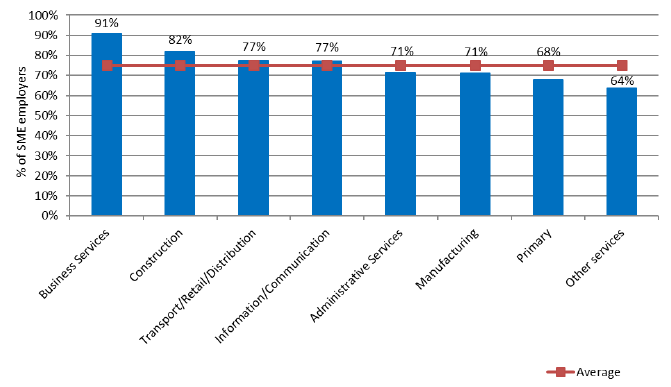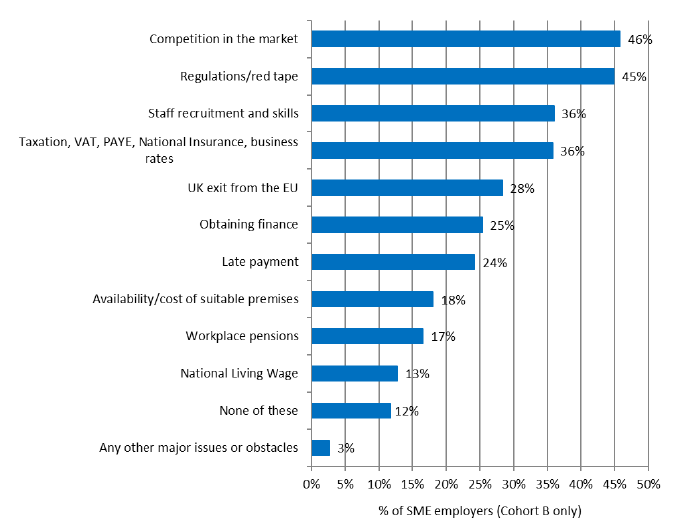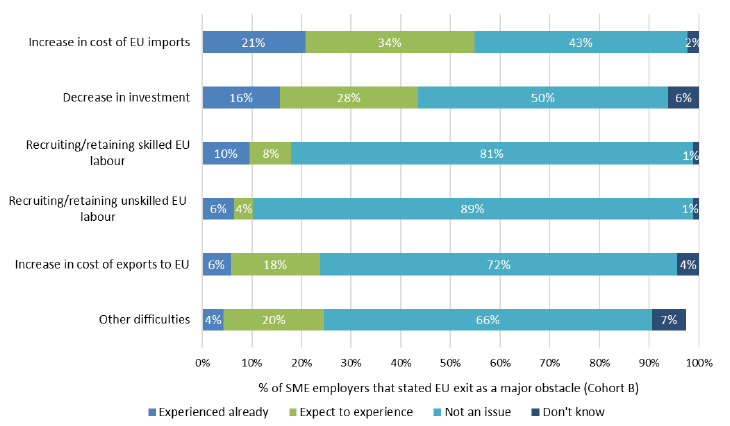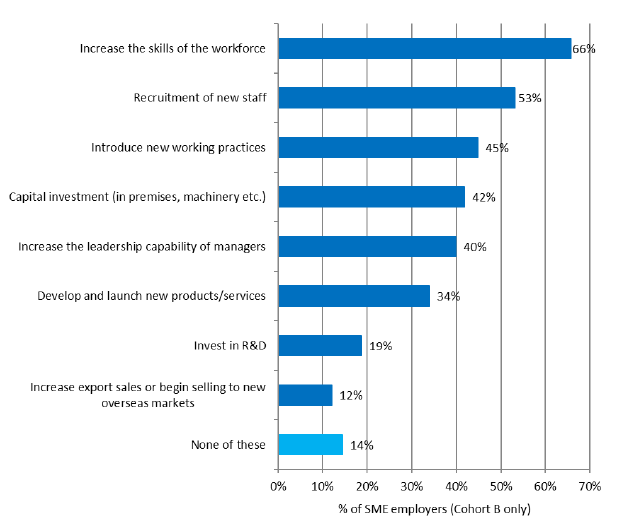Small Business Survey Scotland: 2018
Sets out the findings of the Small Business Survey 2018.
This document is part of a collection
6. Business Performance and Outlook
The survey captures the opinions of SME employers on how they performed in the past 12 months and what they expect for the coming year, in terms of changes in employment size and turnover.
Changes to employment in the last 12 months[36]
Of all SME employers that had been trading for at least one year, 21 per cent employed more people than a year previously, in line with the proportion for the UK as a whole (22 per cent). 12 per cent had fewer employees and 66 per cent employed the same number, broadly similar to the UK as a whole (13 per cent and 64 per cent respectively).
Table 6 below shows the net balance of employment growth by business size. The net balance[37] is described as the overall proportion of businesses that increased employment minus the proportion of businesses that decreased employment, compared to a year ago. Therefore, a positive figure indicates that more businesses within that category increased employment levels than decreased. In 2018, micro, small and medium-sized businesses all showed a positive net balance of employment growth, with medium-sized businesses showing the greatest positive net balance.
Small and medium-sized firms were more likely than average to have employed more people than a year previously. By sector, SME employers in the Construction (33 per cent) and Administrative Services (34 per cent) sectors were more likely than average to have employed more people.
Table 6: Numbers employed compared to 12 months ago (%) by size
Base: all SME employers trading for at least one year, 832 – Base minimum: Medium-sized businesses, 161
| Has more employees now | Same number | Has fewer employees now | Net balance - growth (% points) | |
|---|---|---|---|---|
| Micro 1-9 | 19 | 68 | 12 | 7 |
| Small 10-49 | 27 | 60 | 12 | 15 |
| Medium 50-249 | 35 | 48 | 15 | 20 |
| All | 21 | 66 | 12 | 8 |
Expectations of employment in the next 12 months
23 per cent of SME employers in Scotland expected to employ more people in 12 months’ time, broadly in line with the proportion in the UK as a whole (25 per cent) and with the proportion in the prior year (22 per cent). Nine per cent of SME employers in Scotland expected to employ less people, in line with the UK as a whole (nine per cent) and the proportion in the prior year (8 per cent). 68 per cent of SME employers in Scotland expected to employ about the same number, higher than the proportion in the UK as a whole (64 per cent) and similar to the prior year (70 per cent).
Small (29 per cent) and medium-sized (36 per cent) firms were more likely than average to expect to employ more people in 12 months’ time.
Changes to turnover in the last 12 months
Of all SME employers that had been trading for at least one year, 34 per cent increased their turnover (value of sales) over the past year. 42 per cent had approximately the same turnover and 19 per cent had seen their turnover decrease over the past year. These proportions were broadly in line with those in the UK as a whole.
Table 7 below shows the net balance of turnover growth by business size[38]. SME employers of all sizes showed a positive net balance of turnover growth (i.e. higher proportions of firms experienced turnover growth than those that experienced turnover reduction).
Small and medium-sized businesses were more likely than average to have seen their turnover increase over the past year.
Table 7: Changes to turnover compared to 12 months previously (%) by size
Base: all SME employers trading for at least one year, 832 – Base minimum: Medium-sized businesses, 161
SME employers that answered Don’t know/Refused: 5%
| Increased | Decreased | Stayed the same | Net balance - growth (% points) | |
|---|---|---|---|---|
| Micro 1-9 | 31 | 21 | 43 | 10 |
| Small 10-49 | 45 | 12 | 37 | 33 |
| Medium 50-249 | 51 | 13 | 30 | 38 |
| All | 34 | 19 | 42 | 14 |
Expectations of turnover growth in the next 12 months
38 per cent of SME employers in Scotland expected turnover to increase in the next 12 months and 45 per cent expected turnover to stay approximately the same. These proportions were broadly in line with those in the UK as a whole. 13 per cent of SME employers expected turnover to decrease, higher than the proportion in the UK as a whole (10 per cent).
Medium-sized SME employers were more likely than average to expect turnover to increase (54 per cent).
Profit
77 per cent of SME employers in Scotland generated a profit in their last financial year, in-line with the UK as a whole (76 per cent) and broadly similar to the prior year (80 per cent). The proportion of SME employers generating a profit was broadly consistent across business size-band.
Businesses in the business services sector (91 per cent) were more likely than average to have generated a profit, whereas businesses in the other services sector were less likely than average to have made a profit (64 per cent). The results for all other sectors were broadly in line with the overall SME average (Figure 21).
Figure 21: Whether generated a profit or surplus in the last financial year by sector
Base: all SME employers, 836 – Base minimum: Information/Communication, 35
SME employers that answered Don’t know/Refused to this question: 3%

Major obstacles to the success of the business (Cohort B only)
Respondents were read a list of issues and asked which, if any, represented major obstacles to the success of their business. In line with the prior year and the UK as whole, the two most commonly reported obstacles by SME employers in Scotland were competition in the market (reported by 46 per cent of SME employers) and regulations/red tape (45 per cent).
Other commonly reported obstacles included staff recruitment and skills (36 per cent), taxation/VAT/PAYE/National Insurance/business rates (36 per cent) and UK exit from the EU (28 per cent) (Figure 22). 25 per cent also reported obtaining finance as a major obstacle, higher than the UK as a whole at 17 per cent. Late payment as a major obstacle was reported by 24 per cent of businesses, down from 32 per cent in 2017 and lower than the UK as a whole (33 per cent).
Figure 22: Major obstacles to the success of the business
Base: SME employers (Cohort B only), 277
Multiple answers allowed to this question.

The proportion of SME employers in Scotland reporting UK exit from the EU as a major obstacle (28 per cent) was broadly in line with the prior year (30 per cent). The proportion of SME employers in the UK as a whole reporting this as a major obstacle increased over the latest year from 27 per cent to 29 per cent.
In a new question for 2018, those SME employers that reported UK exit from the EU as a major obstacle to the success of their business[39] were asked whether they had already experienced or expected to experience a number of specific difficulties (Figure 23)[40].
In terms of difficulties already experienced, the most commonly reported answer was an increase in the cost of EU imports (21 per cent of SME employers reporting Brexit as a major obstacle), broadly in line with the UK as a whole (24 per cent).
An increase in the cost of EU imports was also the most commonly reported difficulty that SME employers expected to experience (34 per cent), in line with the UK as a whole (34 per cent).
Figure 23[41]: Whether experienced difficulties as a result of UK exit from the EU, 2018
Base: all that stated UK exit from the EU as a major obstacle (Cohort B only), 85

Growth ambitions
70 per cent of SME employers stated that they aimed to grow sales over the next three years, an increase of ten percentage points from 2017 (60 per cent) and broadly in line with the proportion in the UK as a whole (71 per cent). Small (80 per cent) and medium-sized businesses (86 per cent) were more likely than average to have growth ambitions.
By sector, SME employers in the Administrative Services sector were more likely than average to report that they aimed to grow future sales (88 per cent), while SME employers in the Construction sector were less likely than average to report that they aimed to grow sales (57 per cent).
Plans to undertake growth-related activities (Cohort B only)
SME employers were asked whether they planned to do any of seven growth-related activities over the next three years. The most commonly reported activity was ‘increase the skills of the workforce’, cited by 66 per cent of SME employers and seven percentage points higher than the prior year (59 per cent). The least reported activity was ‘increase export sales or begin selling to new overseas markets’, cited by 12 per cent of SME employers (Figure 24).
Small (81 per cent) and medium-sized (84 per cent) firms were more likely than average to plan to ‘increase the skills of the workforce’ over the next three years.
Figure 24: Whether plan to do any of these growth-related activities
Base: all SME employers (Cohort B only), 277

Whether plans for growth-related activities have been affected by UK exit from the EU (Cohort B only)
Those SME employers who stated that they planned to undertake any growth-related activities[42] over the coming three years were asked whether their plans had been affected by the UK’s exit from the EU. Those SME employers in Scotland with plans to develop and launch new products/ services (six per cent) and recruit new staff (six per cent) were most likely to have had these plans affected by EU exit. Five per cent of SME employers in Scotland with capital investment plans, four per cent of those with plans to introduce new working practices and three per cent of those with plans to increase export sales or begin selling to new overseas markets also stated that these plans had been affected by UK exit. These results were similar to those for the UK as a whole.
The proportion of SME employers reporting that none of these growth-related activities have been affected by the UK exit from the EU was 79 percent, broadly similar to the proportion in 2017 (84 per cent) and the UK as a whole (77 per cent).
Contact
Email: industrystatistics@gov.scot
There is a problem
Thanks for your feedback